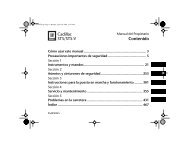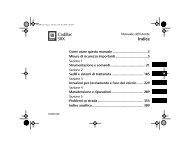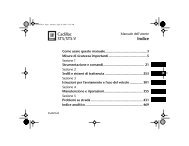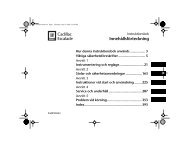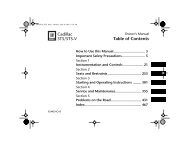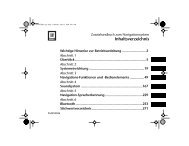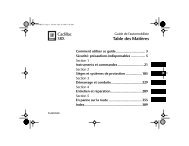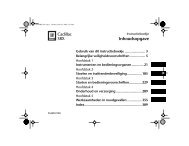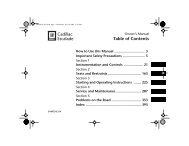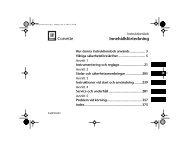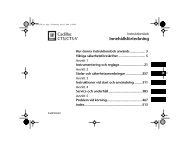Owner's Manual Cadillac BLS - IFS Europe BV
Owner's Manual Cadillac BLS - IFS Europe BV
Owner's Manual Cadillac BLS - IFS Europe BV
Create successful ePaper yourself
Turn your PDF publications into a flip-book with our unique Google optimized e-Paper software.
460_OM_MY09.book Page 129 Wednesday, April 2, 2008 10:32 AM<br />
Important<br />
considerations for<br />
driving<br />
Cars with turbo petrol engine<br />
1 Starting and driving.<br />
• Do not use full throttle until the engine<br />
is warm, so as to avoid unnecessary<br />
wear. If the needle of the turbo gauge<br />
repeatedly enters the red zone, the<br />
engine may suddenly lose power due to<br />
the initiation of a monitoring system<br />
that limits the boost pressure. We recommend<br />
that you contact an authorised<br />
<strong>Cadillac</strong> workshop immediately.<br />
• Under certain barometric conditions<br />
(high outside temperature and/or high<br />
altitude) the needle may enter the first<br />
part of the red zone without necessarily<br />
indicating that a fault has arisen.<br />
• A protective function (interruption of the<br />
fuel supply) limits the engine speed.<br />
2 Stopping the engine.<br />
• Do not rev the engine immediately<br />
before switching it off - stop the engine<br />
when it is idling.<br />
3 Boost pressure regulation.<br />
• The system is optimised for RON 95,<br />
but for 2.8 V6 RON 98 is used. One of<br />
the advantages of boost pressure regulation<br />
is that the engine can also be<br />
run safely on petrol with a lower octane<br />
rating, although not lower than<br />
91 RON, without damaging the engine.<br />
However, engine performance will fall<br />
slightly and heavy loading and<br />
labouring should be avoided. For<br />
optimum performance, use the recommended<br />
grade of fuel.<br />
• The maximum boost pressure is regulated<br />
according to the tendency of the<br />
engine to knock. Short-lived knocking<br />
is perfectly normal. This can occur<br />
when the engine is running at about<br />
3000 rpm under a heavy load. The<br />
extent of this knocking will depend on<br />
the grade of fuel in the tank.<br />
• Isolated instances of knocking can<br />
occur with low-octane fuel. This controlled<br />
form of knocking, followed by a<br />
reduction in the boost pressure, is a<br />
sign that the control system is working<br />
normally, and is perfectly safe for the<br />
engine.<br />
NOTICE<br />
Starting and driving<br />
129<br />
• If the engine sounds strange there is a<br />
malfunction. We recommend that you<br />
contact an authorised <strong>Cadillac</strong> workshop.<br />
• The use of fuel with too low an octane<br />
rating can cause serious engine<br />
damage.<br />
Limited performance.<br />
The light 3 comes on in the event of an<br />
engine or gearbox fault (cars with automatic<br />
gearbox), which can cause driveability<br />
problems but does not affect exhaust emission.<br />
The car can still be driven but perhaps<br />
with limited performance.<br />
Contact a workshop when you find it suitable.<br />
We recommend that you contact an<br />
authorised <strong>Cadillac</strong> workshop.




